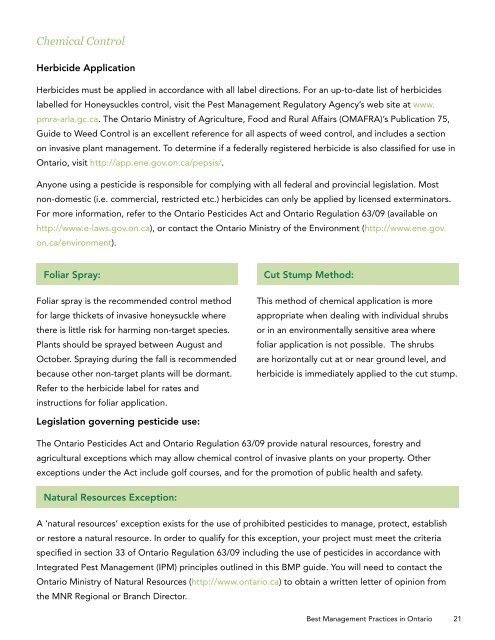OIPC_BMP_Honeysuckle_Feb182014_FINAL2
OIPC_BMP_Honeysuckle_Feb182014_FINAL2
OIPC_BMP_Honeysuckle_Feb182014_FINAL2
You also want an ePaper? Increase the reach of your titles
YUMPU automatically turns print PDFs into web optimized ePapers that Google loves.
Chemical Control<br />
Herbicide Application<br />
Herbicides must be applied in accordance with all label directions. For an up-to-date list of herbicides<br />
labelled for <strong>Honeysuckle</strong>s control, visit the Pest Management Regulatory Agency’s web site at www.<br />
pmra-arla.gc.ca. The Ontario Ministry of Agriculture, Food and Rural Affairs (OMAFRA)’s Publication 75,<br />
Guide to Weed Control is an excellent reference for all aspects of weed control, and includes a section<br />
on invasive plant management. To determine if a federally registered herbicide is also classified for use in<br />
Ontario, visit http://app.ene.gov.on.ca/pepsis/.<br />
Anyone using a pesticide is responsible for complying with all federal and provincial legislation. Most<br />
non-domestic (i.e. commercial, restricted etc.) herbicides can only be applied by licensed exterminators.<br />
For more information, refer to the Ontario Pesticides Act and Ontario Regulation 63/09 (available on<br />
http://www.e-laws.gov.on.ca), or contact the Ontario Ministry of the Environment (http://www.ene.gov.<br />
on.ca/environment).<br />
Foliar Spray:<br />
Foliar spray is the recommended control method<br />
for large thickets of invasive honeysuckle where<br />
there is little risk for harming non-target species.<br />
Plants should be sprayed between August and<br />
October. Spraying during the fall is recommended<br />
because other non-target plants will be dormant.<br />
Refer to the herbicide label for rates and<br />
instructions for foliar application.<br />
Cut Stump Method:<br />
This method of chemical application is more<br />
appropriate when dealing with individual shrubs<br />
or in an environmentally sensitive area where<br />
foliar application is not possible. The shrubs<br />
are horizontally cut at or near ground level, and<br />
herbicide is immediately applied to the cut stump.<br />
Legislation governing pesticide use:<br />
The Ontario Pesticides Act and Ontario Regulation 63/09 provide natural resources, forestry and<br />
agricultural exceptions which may allow chemical control of invasive plants on your property. Other<br />
exceptions under the Act include golf courses, and for the promotion of public health and safety.<br />
Natural Resources Exception:<br />
A ‘natural resources’ exception exists for the use of prohibited pesticides to manage, protect, establish<br />
or restore a natural resource. In order to qualify for this exception, your project must meet the criteria<br />
specified in section 33 of Ontario Regulation 63/09 including the use of pesticides in accordance with<br />
Integrated Pest Management (IPM) principles outlined in this <strong>BMP</strong> guide. You will need to contact the<br />
Ontario Ministry of Natural Resources (http://www.ontario.ca) to obtain a written letter of opinion from<br />
the MNR Regional or Branch Director.<br />
Best Management Practices in Ontario<br />
21



